




Representing Data on Bar Graph: An Introduction
A bar graph is a chart or a graphical depiction of information, amounts, or numbers using bars or strips. To make a comparison of numbers, frequencies, or other measurements of different categories of data, bar graphs are used. The bars offer a visual representation for comparing quantities in different categories. Bar graphs contain the x and y axes, also referred to as the horizontal and vertical axes, as well as the title, labels, and bars. Each bar's height can be used to display information such as the number of items in each category or the frequency of an event. Let's describe what a bar graph is, how kids are taught to recognise them, how to make a bar graph on graph paper, and how to make one with groups of discrete data.
Types of Bar Graph
There are mainly two types of bar graphs: horizontal graph and vertical graph.
Vertical Bar Graphs: Vertical bar graphs are those in which the given data are displayed vertically in a graph or chart with the aid of rectangular bars that display the measure of data. The y-axis displays the value of the height of the rectangular bars, which indicates the quantity of the variables written on the x-axis, and the rectangular bars are drawn vertically on the x-axis.
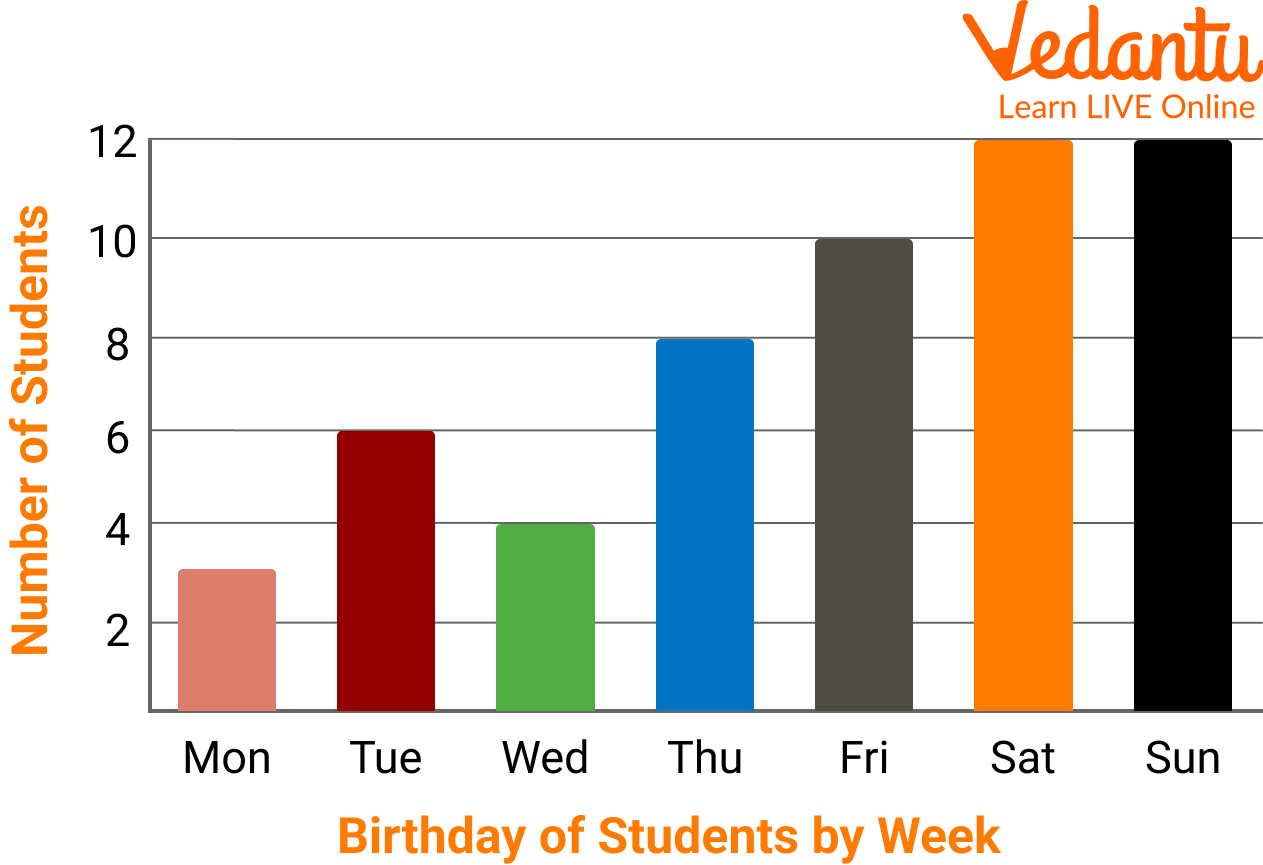
Vertical Bar Graphs
Horizontal Bar Graphs: These graphs are referred to as horizontal bar graphs when the given data is displayed horizontally by employing rectangular bars that display the data's measure. In this type, the categories or variables of the data must be put down before the rectangular bars are drawn horizontally on the y-axis and the length of the bars is displayed on the x-axis as the values of the various variables present in the data.

Horizontal Bar Graphs
Bar Graph of Population
Create a bar graph using the information below.
India's population in each of the subsequent census years:
We use the years on the X-axis and the population on the Y-axis to build the graph. We plot the graph in rectangles each year by assuming that both axes have a scale, which implies that we use 10 years as one unit, which will be the width of the rectangle, and the population as the length of the rectangle.
Let's now establish a table with the coordinates of the points that will be shown on the graph in one column, as shown below.
Let's use the scale now.
10 years are equal to 1 unit on the X-axis.
One unit equals 100 million on the Y-axis.
Let's plot the given data's bar graph using this scale.

Bar Graph of Population
As a result, a bar graph showing the provided data is created.
How to Draw a Bar Graph on a Graph Paper?
With the aid of an example, let's learn how to draw a bar graph. Liza visited the market to purchase a variety of fruits, including 5 apples, 3 mangoes, 2 watermelons, 3 strawberries, and 6 oranges. She wants to create a bar graph to visualize the data so she can see what kinds of fruits she purchases the most frequently.
Let's use the next few stages to create a bar graph of the fruit that is most frequently purchased.
Step 1: Take a piece of graph paper, and label the bars with a caption like "Most Bought Fruit."
Step 2: On a plane, draw the horizontal (x-axis) and vertical (y-axis) axes.
Step 3: Next, give the horizontal axis, which is an independent category, the name "Types of Fruits," and the vertical axis, which is a dependent category, the name "Number of Fruits."
Step 4: Write the names of the fruits on the horizontal axis, such as apples, mangoes, watermelon, strawberries, and oranges, and leave an equal gap or spacing between each fruit.
Step 5: Describe the graph's scale, which demonstrates how numbers are used in the data. It is a system of markers spaced at specific intervals that aids in object measurement. The scale of a graph, for instance, could be expressed as 1 unit = 1 fruit.
Step 6: Start constructing rectangular bars for each fruit, leaving equal spaces between them, and assigning heights to the corresponding numbers.
Step 7: Now that the bar graph is complete, determine which fruit is the most popular by measuring the height of the rectangle bars for each fruit.
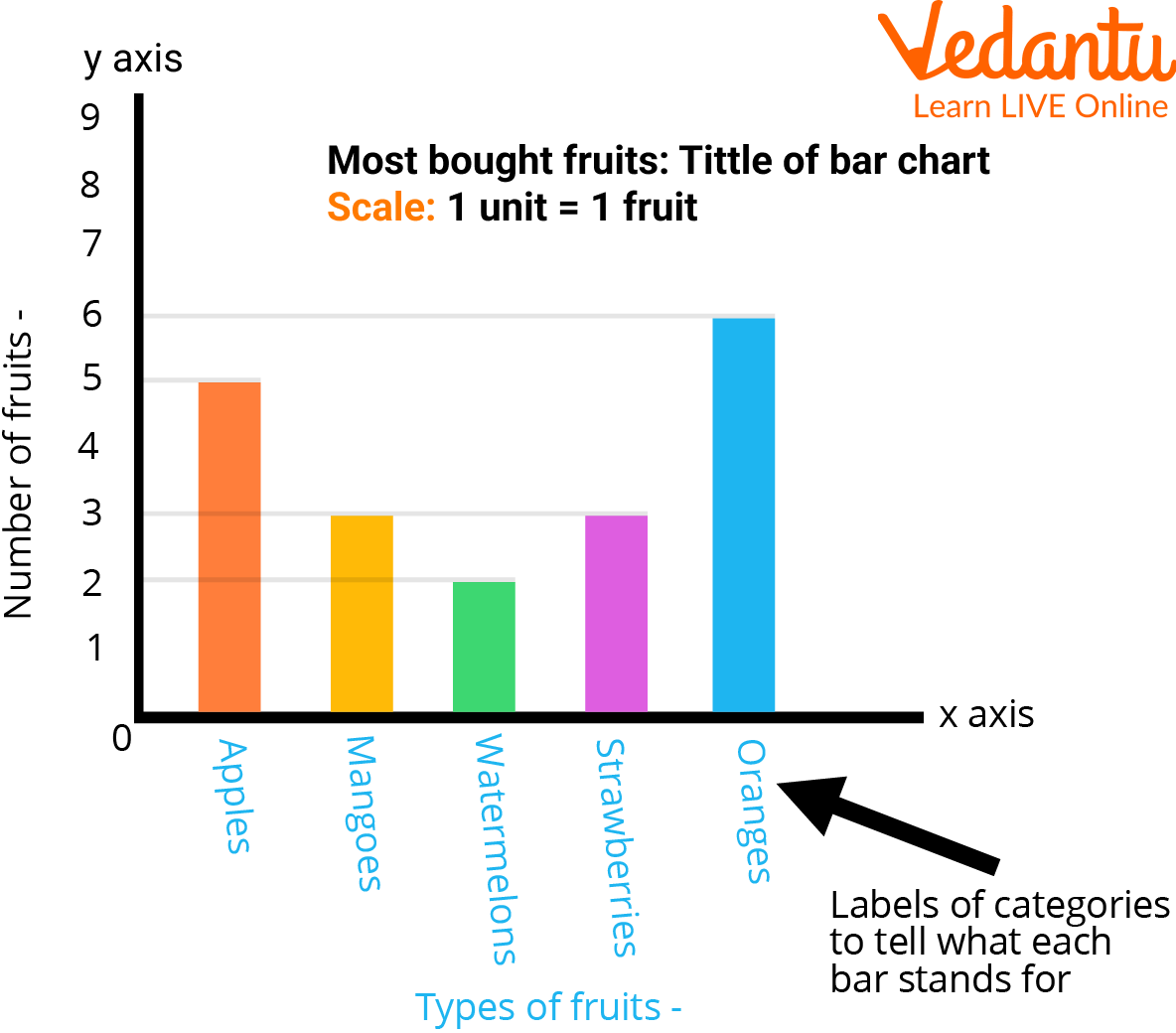
Bar Graph on Graph Paper
We may conclude from the graph above that Liza purchases oranges more frequently than any other fruit.
Green Bar Graph Paper
A piece of writing paper with thin lines printed on it to create a regular grid is known as graph paper, coordinate paper, grid paper, or squared paper. When producing graphs of functions or experimental data and sketching curves, the lines are frequently used as a guide. The green graph is one of the most often used graph papers with color-coded labels that you'll find. Graph paper is a generic term for a sheet of paper with grids or fine lines on it. These tiny lines are what give the paper's grid its ultimate shape as a graph. We use green graph paper to make bar graphs.
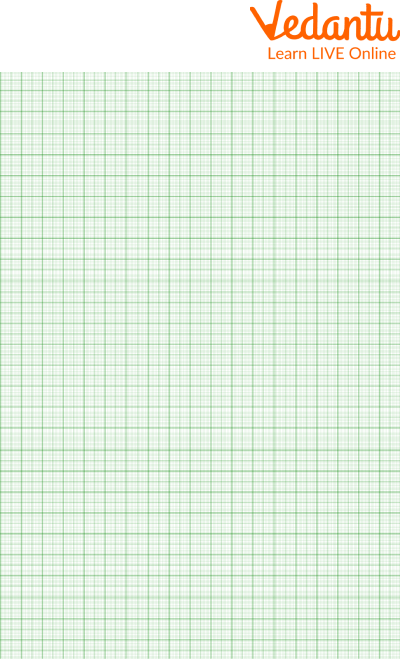
Green Graph Paper
Solved Examples
Example 1: We surveyed 100 youngsters to find out about their preferred method of transportation to school. The table below lists the findings of this survey. Draw a bar graph to illustrate this data.
Ans: We must first determine from the data in the table what our graph's requirements will be before we can create the bar graph:The y-axis scale must extend at least as high as 35 because there are 5 categories and there must be space for 5 bars. The highest frequency is 35.
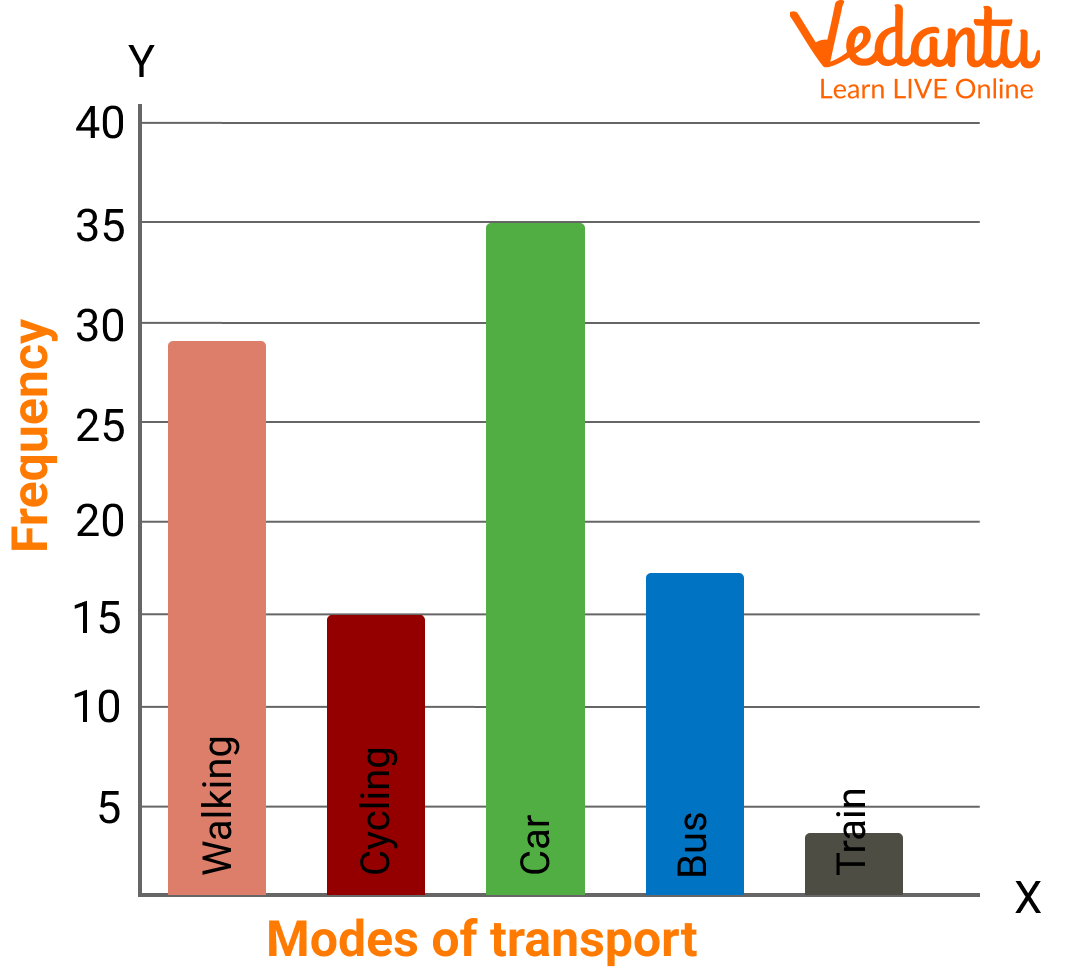
Bar Graph
Example 2: The data of a student's class test is given below. Draw a bar graph to illustrate this data.
Ans: The bar graph of the given data is given below:

Bar Graph
Practice Problems
1. A survey of 5 bike companies was conducted to determine "Which company sold the maximum bikes?"
Draw a horizontal bar graph for the given data.
Ans: Bar graph for the given data is:
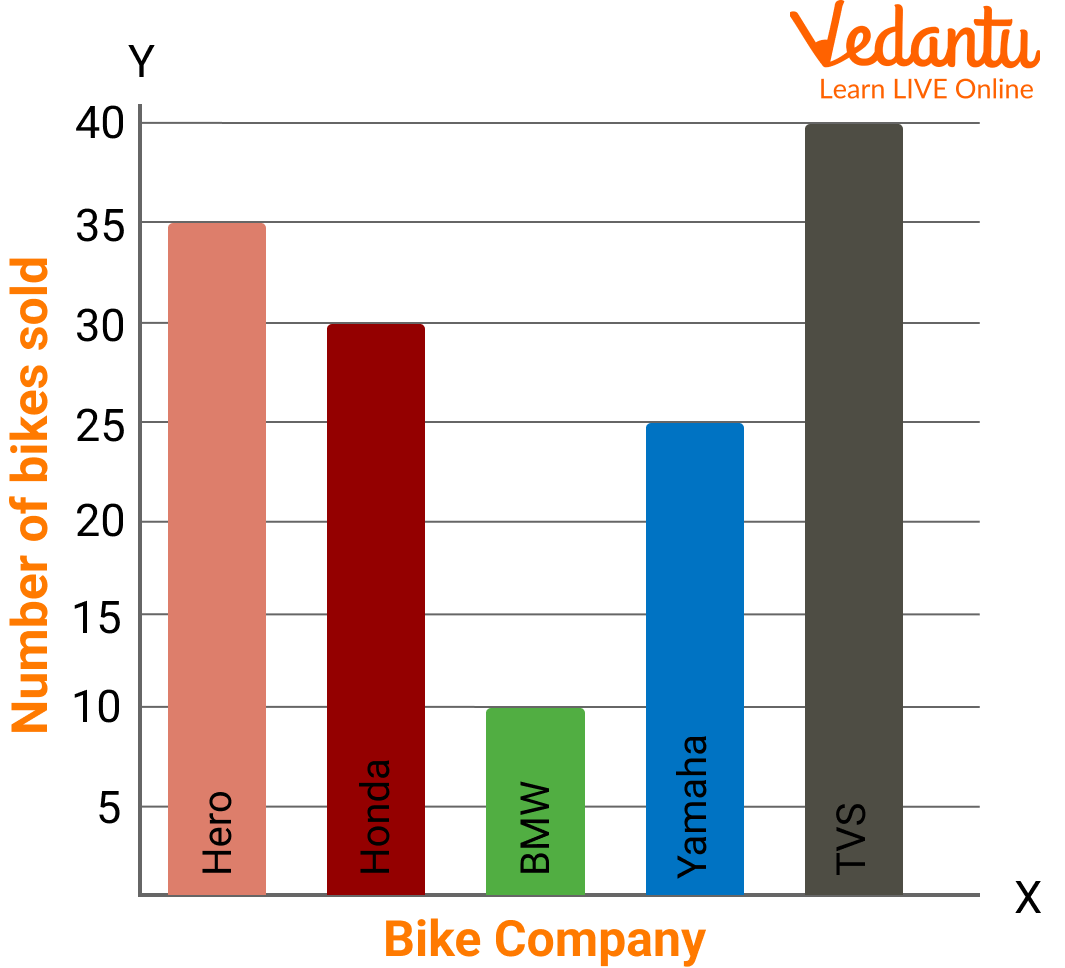
Bar Graph
TVS sold the maximum bike.
Summary
In this article we learned about a bar chart, often known as a bar graph, which is a diagram that displays categorical data as rectangular bars with heights or lengths proportional to the values they stand for. Bar graphs and charts give categorical data a visual representation. Categorical data is the categorization of data into distinct groups, such as age range, shoe size, and animal species. Typically, these classifications are qualitative.
FAQs on Representing Data on Bar Graph
1. What is a bar graph and how does it visually represent data in mathematics?
A bar graph is a graphical way to represent data using rectangular bars to show quantities or numbers for different categories. The height or length of each bar reflects the value it represents. This method makes it easy to compare different groups or sections of data in a quick, visual format, as per the CBSE syllabus for 2025–26.
2. What are the main types of bar graphs, and when should each type be used in data representation?
The two main types of bar graphs are:
- Vertical bar graphs: Bars are drawn vertically from the x-axis; best used when categories are discrete, such as different fruits or years.
- Horizontal bar graphs: Bars are drawn horizontally from the y-axis; useful when category names are long or there are many categories to display clearly.
3. How do you draw a proper bar graph on graph paper according to CBSE guidelines?
To draw a bar graph on graph paper:
- Label both axes: the x-axis (horizontal) for categories and the y-axis (vertical) for values.
- Choose an appropriate scale for the y-axis.
- Mark categories evenly spaced on the x-axis.
- Draw rectangular bars for each category, their heights corresponding to the data value.
- Keep bars of equal width and leave equal spaces between them.
- Give the graph a title that clearly describes what the data shows.
4. Why is scaling important when creating a bar graph, and how do you choose a suitable scale?
Scaling is essential in a bar graph because it ensures that the bars accurately represent the quantities involved. To choose a suitable scale, consider the range of data values; the highest value should fit comfortably within the graph’s axes. For example, if data ranges from 1 to 40, you might use a scale like 1 unit = 5 or 10. Proper scaling helps in maintaining clarity and proper proportion among bars.
5. What are common mistakes students should avoid when representing data on a bar graph?
Students should avoid:
- Using uneven widths or spacing between bars
- Not labeling axes or giving vague titles
- Choosing a scale that doesn't suit the data range
- Placing bars too close (bars in bar graphs should be separated, unlike histograms)
- Presenting continuous data in a bar graph instead of categorical data
6. What is the difference between a bar graph and a histogram, especially in handling data types?
The key difference is that bar graphs are used to display categorical data (distinct categories), and the bars are separated. Histograms are used for continuous data (ranges of values), and the bars touch each other, showing frequency distributions.
7. How can a bar graph help in analysing trends in real-world data as per the CBSE syllabus?
A bar graph makes it easier to see and compare quantities across categories, spot trends such as the most or least popular item, and quickly summarise large sets of information. In real-world contexts, such as surveys or census data, bar graphs simplify analysis and support decision-making by highlighting differences visually.
8. What is the significance of using green graph paper when representing data on a bar graph for mathematics projects?
Green graph paper provides a clear grid that helps students accurately plot points and draw bars. The contrast makes it easier to read and maintain neatness, which is important for scoring on CBSE projects where presentation is evaluated.
9. How can bar graphs be used to identify outliers or unusual data points in a dataset?
If one bar is significantly taller or shorter than the others, it indicates an outlier or unusual value in the data. Bar graphs make outliers visually apparent, which prompts further investigation into why those values occurred.
10. In what ways do bar graphs support questions carrying high marks in CBSE board exams, and how should one present answers involving bar graphs?
Bar graphs are often used in 5-mark or 3-mark board questions that test both data interpretation and graphical presentation skills. To score full marks, ensure:
- The graph is neat and drawn with a ruler
- Scales and axes are labeled
- A proper title is included
- Bars are accurately drawn as per data
- A short interpretation sentence is added, if asked
11. How can understanding the difference between vertical and horizontal bar graphs enhance your exam answers?
Choosing between vertical and horizontal bar graphs based on the type and length of category labels can make your answers clearer and more visually effective. Demonstrating this understanding may help you gain additional marks for presentation and application skills during board exams.
12. What is the impact of not maintaining equal gaps between the bars of a bar graph?
Unequal gaps between bars can misrepresent the data visually and cause confusion for readers. It can also result in loss of marks in CBSE exams as it violates the standard conventions for constructing bar graphs, which require equal spacing for clarity and fairness in comparison.











